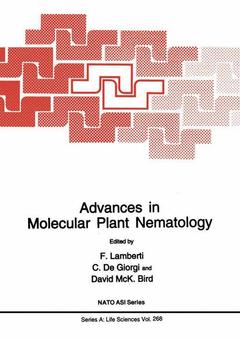Description
Advances in Molecular Plant Nematology, 1994
NATO Science Series A: Series, Vol. 268
Coordinators: Lamberti F., Oe Giorgi C., Bird David McK.
Language: English
Subjects for Advances in Molecular Plant Nematology:
Keywords
Nucleotide; development; nematology; plant pathogens; roots; systematics
Publication date: 05-2013
312 p. · 17.8x25.4 cm · Paperback
312 p. · 17.8x25.4 cm · Paperback
Description
/li>Contents
/li>
Plant parasitic nematodes are a main pest to crops. For ex am pie, the root-knot nematodes belonging to the genus Meloidogyne are worldwide in their distribution and attack almost every type of crop, causing considerable losses of yield and affecting quality of produce. The cyst nematodes within the genera Globodera and Heterodera constitute a major group of plant pathogens in many countries throughout the world, suppressing yields of potato, sugar beet, soybean and cereals. Several nematodes such as longidorids and trichodorids are implicated in the transmission of numerous plant viruses. Many others cause constraints to agricultural production either locally or on large areas. However, despite their economic importance (they account for worldwide crop reduction in excess of 10%), plant parasitic nematodes are still poorly understood, because most of them are obligate parasites of roots. Environmental concerns over the agricultural use of pesticides demand the development of alternative measures to control them. To achieve environmentally sound control, knowledge of the basic biology of nematodes must be expanded. Important research areas include understanding the molecular bases for pathogenicity, the molecular mechanisms of the host parasite interactions and the genetic bases for population fluctuations. The workshop has, for the first time, brought together an international group of researchers using molecular approaches to study plant parasitic nematodes and their host responses.
I Nematode Genetics.- The Caenorhabditis Elegans Genome Project.- Genetic Analysis in Caenorhabditis Elegans.- Transposable Elements in Nematodes.- Linkage Mapping in Potato Cyst Nematodes.- Genetic Analysis of the Soybean-Heterodera Glycines Interaction.- Molecular Characterization of the Burrowing Nematode Sibling Species, Radopholus Citrophilus and R. Similis.- Cuticlin Gene Organization in Meloidogyne Artiellia.- Genetic Variation in Tropical Meloidogyne Spp..- II Identification of Nematodes.- Nucleotide Sequences in Nematode Systematics.- The Use of mtDNA for the Identification of Plant Parasitic Nematodes.- PCR for Nematode Identification.- Perspectives for Genetically Engineered Antibodies for the Identification of Nematodes.- Repetitive DNA in Plant-Parasitic Nematodes: Use for Interspecific and Intraspecific Identification.- III Host-Parasite Interactions: The Plant.- Arabidopsis Thaliana as a Model Host Plant to Study Molecular Interactions with Root-Knot and Cyst Nematodes.-Arabidopsis Thaliana and Heterodera Schachtii: a Versatile Model to Characterize the Interaction between Host Plants and Cyst Nematodes.- Molecular and Cellular Dissection of Giant Cell Function.- Novel Plant Defences against Nematodes.- Molecular Biology of Nematode Resistance in Tomato.- Bioengineering Resistance to Sedentary Endoparasitic Nematodes.- IV Host Parasite Interactions: The Nematode.- Meloidogyne Stylet Secretions.- Chemoreception in Nematodes.- Genetics of Meloidogyne Virulence against Resistance Genes from Solanaceous Crops.- Molecular Approaches to an Understanding of the Transmission of Plant Viruses by Nematodes.- Characterization of Resistance Genes in Beta Spp. and Identification of Virulence Genes in Heterodera Schachtii.- Participants.
© 2024 LAVOISIER S.A.S.




